Auditing Theory & Practice: Auditor's Review of Governance - ASA 315
VerifiedAdded on 2023/06/10
|9
|2885
|243
Report
AI Summary
This report delves into the auditor's responsibility in reviewing governance, focusing on the requirements outlined in Auditing Standard ASA 315. It summarizes the auditor's duties, including understanding the client's industry, regulatory environment, business operations, and internal controls. The report also addresses issues such as inadequate board oversight, complex decision-making processes, and ineffective risk management frameworks, providing recommendations to mitigate audit risks. Furthermore, it explores ethical considerations for auditors using the American Accounting Association Model, highlighting the importance of integrity and honesty. Finally, the report discusses the role of auditor incorporation and statutory caps on liability, examining alternative liability arrangements and their impact on risk distribution. Desklib provides a platform for students to access this and other solved assignments.
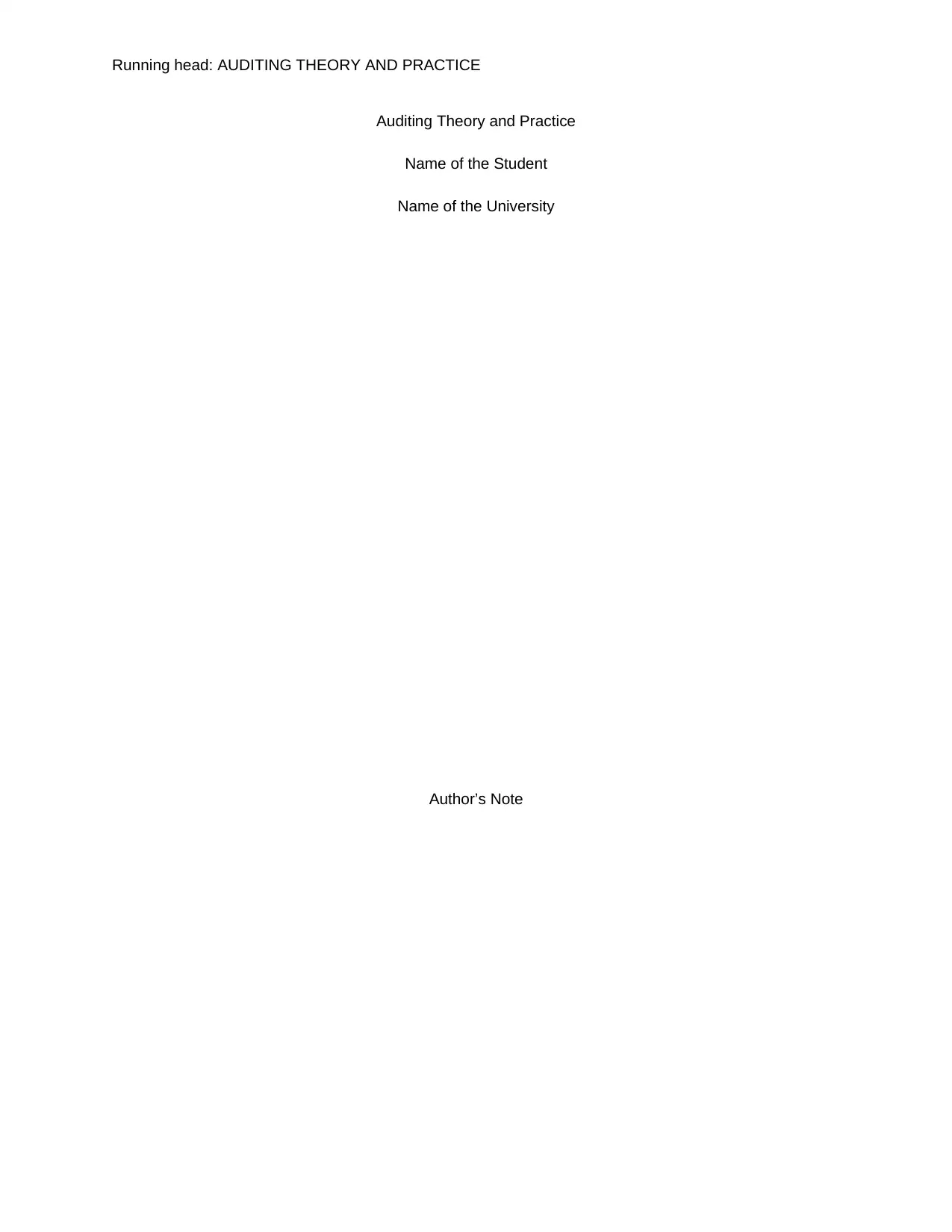
Running head: AUDITING THEORY AND PRACTICE
Auditing Theory and Practice
Name of the Student
Name of the University
Author’s Note
Auditing Theory and Practice
Name of the Student
Name of the University
Author’s Note
Paraphrase This Document
Need a fresh take? Get an instant paraphrase of this document with our AI Paraphraser
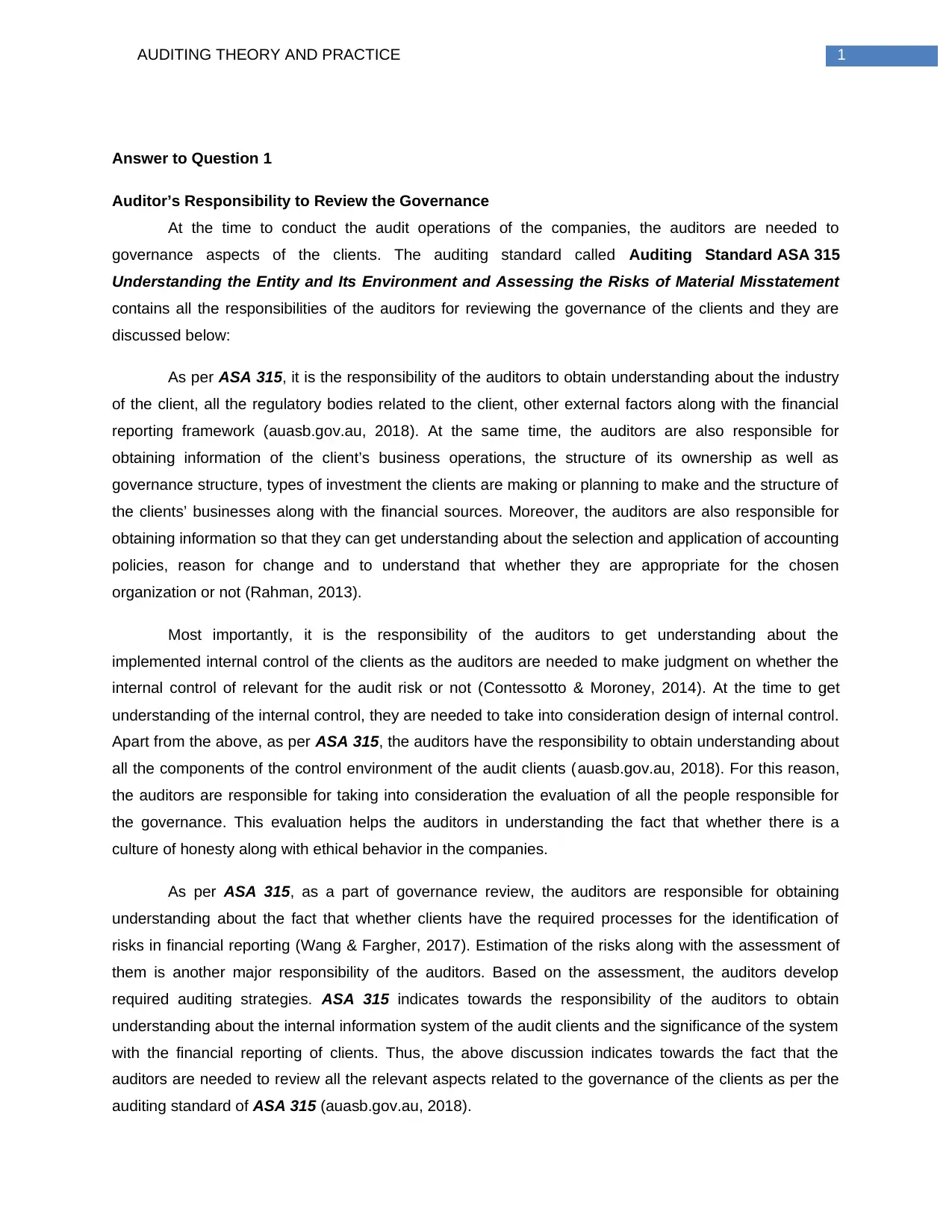
1AUDITING THEORY AND PRACTICE
Answer to Question 1
Auditor’s Responsibility to Review the Governance
At the time to conduct the audit operations of the companies, the auditors are needed to
governance aspects of the clients. The auditing standard called Auditing Standard ASA 315
Understanding the Entity and Its Environment and Assessing the Risks of Material Misstatement
contains all the responsibilities of the auditors for reviewing the governance of the clients and they are
discussed below:
As per ASA 315, it is the responsibility of the auditors to obtain understanding about the industry
of the client, all the regulatory bodies related to the client, other external factors along with the financial
reporting framework (auasb.gov.au, 2018). At the same time, the auditors are also responsible for
obtaining information of the client’s business operations, the structure of its ownership as well as
governance structure, types of investment the clients are making or planning to make and the structure of
the clients’ businesses along with the financial sources. Moreover, the auditors are also responsible for
obtaining information so that they can get understanding about the selection and application of accounting
policies, reason for change and to understand that whether they are appropriate for the chosen
organization or not (Rahman, 2013).
Most importantly, it is the responsibility of the auditors to get understanding about the
implemented internal control of the clients as the auditors are needed to make judgment on whether the
internal control of relevant for the audit risk or not (Contessotto & Moroney, 2014). At the time to get
understanding of the internal control, they are needed to take into consideration design of internal control.
Apart from the above, as per ASA 315, the auditors have the responsibility to obtain understanding about
all the components of the control environment of the audit clients (auasb.gov.au, 2018). For this reason,
the auditors are responsible for taking into consideration the evaluation of all the people responsible for
the governance. This evaluation helps the auditors in understanding the fact that whether there is a
culture of honesty along with ethical behavior in the companies.
As per ASA 315, as a part of governance review, the auditors are responsible for obtaining
understanding about the fact that whether clients have the required processes for the identification of
risks in financial reporting (Wang & Fargher, 2017). Estimation of the risks along with the assessment of
them is another major responsibility of the auditors. Based on the assessment, the auditors develop
required auditing strategies. ASA 315 indicates towards the responsibility of the auditors to obtain
understanding about the internal information system of the audit clients and the significance of the system
with the financial reporting of clients. Thus, the above discussion indicates towards the fact that the
auditors are needed to review all the relevant aspects related to the governance of the clients as per the
auditing standard of ASA 315 (auasb.gov.au, 2018).
Answer to Question 1
Auditor’s Responsibility to Review the Governance
At the time to conduct the audit operations of the companies, the auditors are needed to
governance aspects of the clients. The auditing standard called Auditing Standard ASA 315
Understanding the Entity and Its Environment and Assessing the Risks of Material Misstatement
contains all the responsibilities of the auditors for reviewing the governance of the clients and they are
discussed below:
As per ASA 315, it is the responsibility of the auditors to obtain understanding about the industry
of the client, all the regulatory bodies related to the client, other external factors along with the financial
reporting framework (auasb.gov.au, 2018). At the same time, the auditors are also responsible for
obtaining information of the client’s business operations, the structure of its ownership as well as
governance structure, types of investment the clients are making or planning to make and the structure of
the clients’ businesses along with the financial sources. Moreover, the auditors are also responsible for
obtaining information so that they can get understanding about the selection and application of accounting
policies, reason for change and to understand that whether they are appropriate for the chosen
organization or not (Rahman, 2013).
Most importantly, it is the responsibility of the auditors to get understanding about the
implemented internal control of the clients as the auditors are needed to make judgment on whether the
internal control of relevant for the audit risk or not (Contessotto & Moroney, 2014). At the time to get
understanding of the internal control, they are needed to take into consideration design of internal control.
Apart from the above, as per ASA 315, the auditors have the responsibility to obtain understanding about
all the components of the control environment of the audit clients (auasb.gov.au, 2018). For this reason,
the auditors are responsible for taking into consideration the evaluation of all the people responsible for
the governance. This evaluation helps the auditors in understanding the fact that whether there is a
culture of honesty along with ethical behavior in the companies.
As per ASA 315, as a part of governance review, the auditors are responsible for obtaining
understanding about the fact that whether clients have the required processes for the identification of
risks in financial reporting (Wang & Fargher, 2017). Estimation of the risks along with the assessment of
them is another major responsibility of the auditors. Based on the assessment, the auditors develop
required auditing strategies. ASA 315 indicates towards the responsibility of the auditors to obtain
understanding about the internal information system of the audit clients and the significance of the system
with the financial reporting of clients. Thus, the above discussion indicates towards the fact that the
auditors are needed to review all the relevant aspects related to the governance of the clients as per the
auditing standard of ASA 315 (auasb.gov.au, 2018).
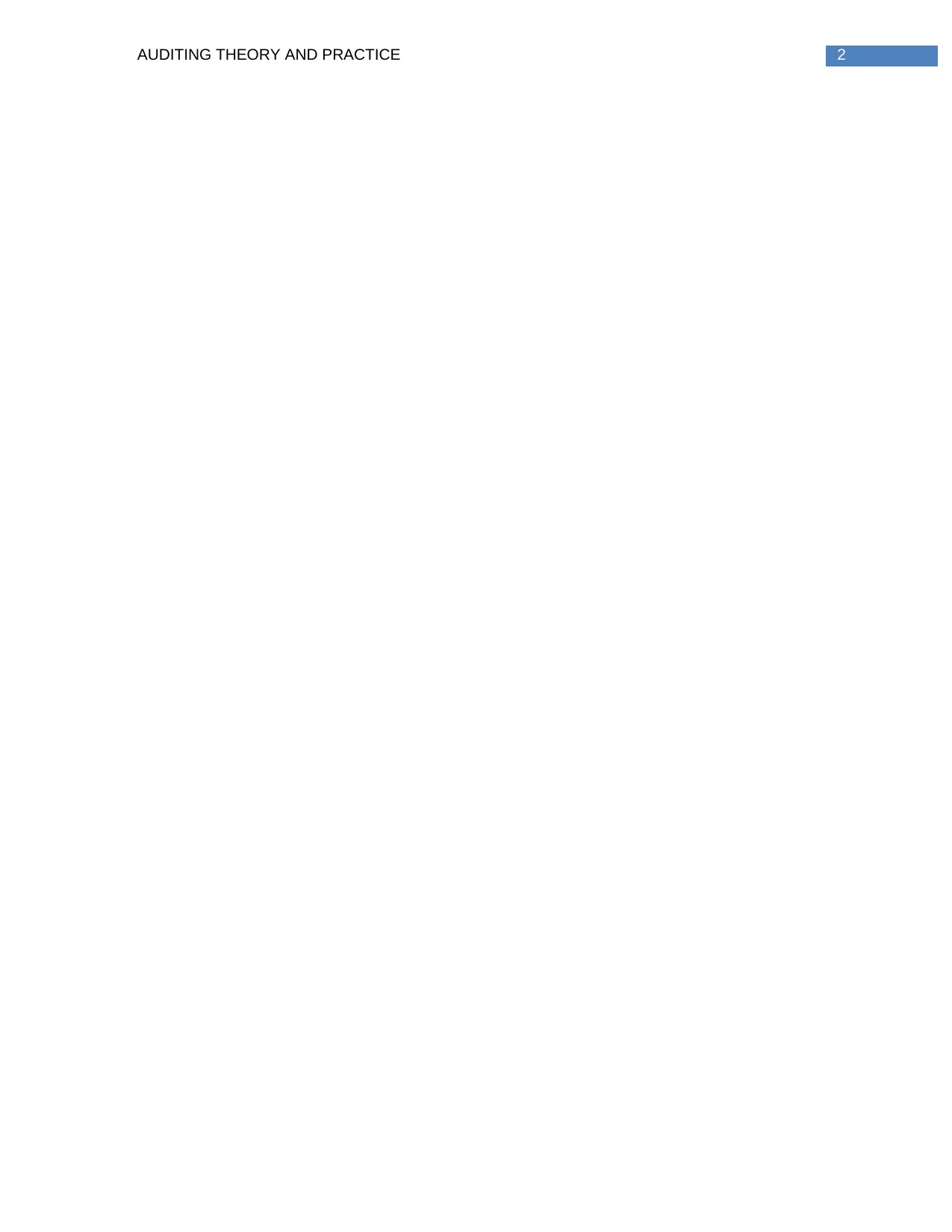
2AUDITING THEORY AND PRACTICE
⊘ This is a preview!⊘
Do you want full access?
Subscribe today to unlock all pages.

Trusted by 1+ million students worldwide
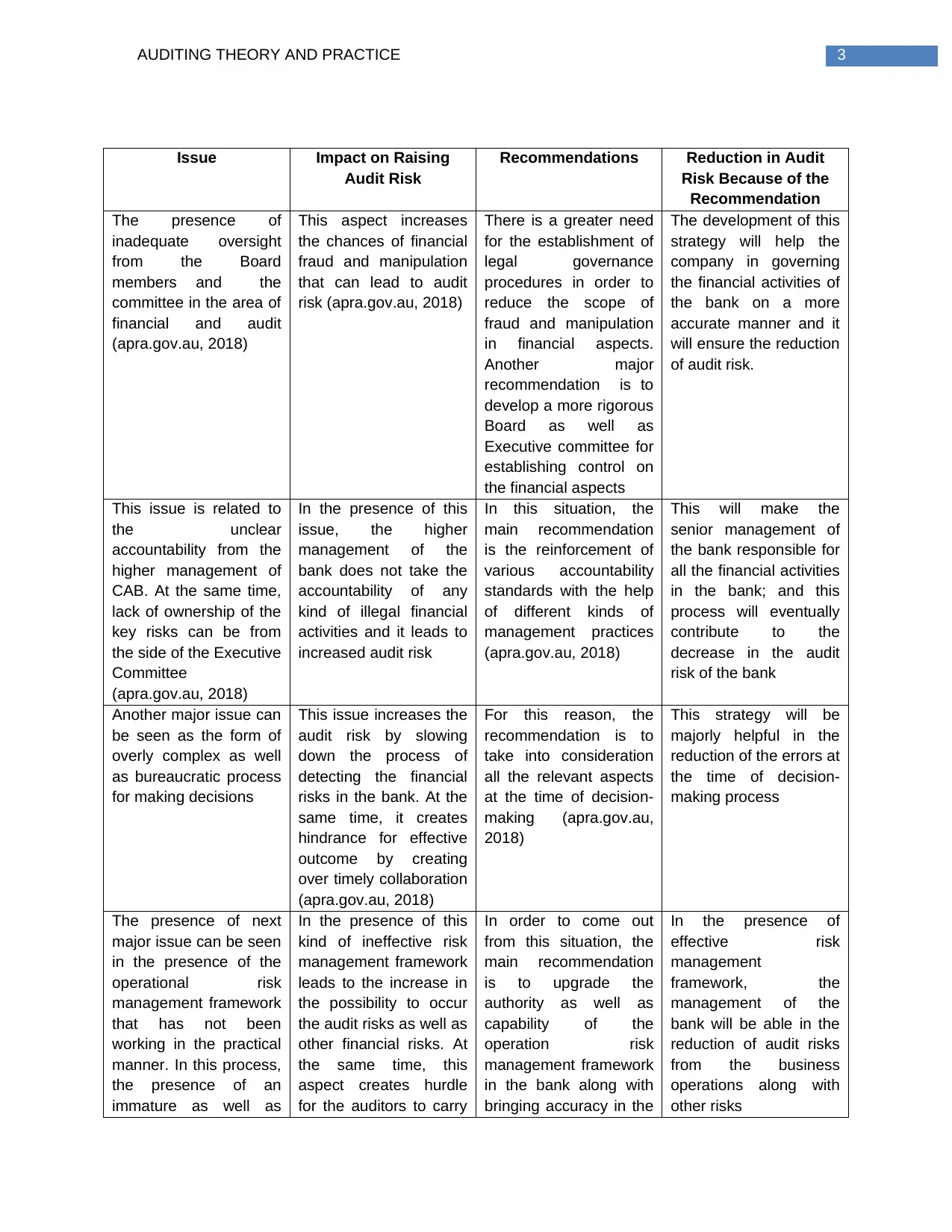
3AUDITING THEORY AND PRACTICE
Issue Impact on Raising
Audit Risk
Recommendations Reduction in Audit
Risk Because of the
Recommendation
The presence of
inadequate oversight
from the Board
members and the
committee in the area of
financial and audit
(apra.gov.au, 2018)
This aspect increases
the chances of financial
fraud and manipulation
that can lead to audit
risk (apra.gov.au, 2018)
There is a greater need
for the establishment of
legal governance
procedures in order to
reduce the scope of
fraud and manipulation
in financial aspects.
Another major
recommendation is to
develop a more rigorous
Board as well as
Executive committee for
establishing control on
the financial aspects
The development of this
strategy will help the
company in governing
the financial activities of
the bank on a more
accurate manner and it
will ensure the reduction
of audit risk.
This issue is related to
the unclear
accountability from the
higher management of
CAB. At the same time,
lack of ownership of the
key risks can be from
the side of the Executive
Committee
(apra.gov.au, 2018)
In the presence of this
issue, the higher
management of the
bank does not take the
accountability of any
kind of illegal financial
activities and it leads to
increased audit risk
In this situation, the
main recommendation
is the reinforcement of
various accountability
standards with the help
of different kinds of
management practices
(apra.gov.au, 2018)
This will make the
senior management of
the bank responsible for
all the financial activities
in the bank; and this
process will eventually
contribute to the
decrease in the audit
risk of the bank
Another major issue can
be seen as the form of
overly complex as well
as bureaucratic process
for making decisions
This issue increases the
audit risk by slowing
down the process of
detecting the financial
risks in the bank. At the
same time, it creates
hindrance for effective
outcome by creating
over timely collaboration
(apra.gov.au, 2018)
For this reason, the
recommendation is to
take into consideration
all the relevant aspects
at the time of decision-
making (apra.gov.au,
2018)
This strategy will be
majorly helpful in the
reduction of the errors at
the time of decision-
making process
The presence of next
major issue can be seen
in the presence of the
operational risk
management framework
that has not been
working in the practical
manner. In this process,
the presence of an
immature as well as
In the presence of this
kind of ineffective risk
management framework
leads to the increase in
the possibility to occur
the audit risks as well as
other financial risks. At
the same time, this
aspect creates hurdle
for the auditors to carry
In order to come out
from this situation, the
main recommendation
is to upgrade the
authority as well as
capability of the
operation risk
management framework
in the bank along with
bringing accuracy in the
In the presence of
effective risk
management
framework, the
management of the
bank will be able in the
reduction of audit risks
from the business
operations along with
other risks
Issue Impact on Raising
Audit Risk
Recommendations Reduction in Audit
Risk Because of the
Recommendation
The presence of
inadequate oversight
from the Board
members and the
committee in the area of
financial and audit
(apra.gov.au, 2018)
This aspect increases
the chances of financial
fraud and manipulation
that can lead to audit
risk (apra.gov.au, 2018)
There is a greater need
for the establishment of
legal governance
procedures in order to
reduce the scope of
fraud and manipulation
in financial aspects.
Another major
recommendation is to
develop a more rigorous
Board as well as
Executive committee for
establishing control on
the financial aspects
The development of this
strategy will help the
company in governing
the financial activities of
the bank on a more
accurate manner and it
will ensure the reduction
of audit risk.
This issue is related to
the unclear
accountability from the
higher management of
CAB. At the same time,
lack of ownership of the
key risks can be from
the side of the Executive
Committee
(apra.gov.au, 2018)
In the presence of this
issue, the higher
management of the
bank does not take the
accountability of any
kind of illegal financial
activities and it leads to
increased audit risk
In this situation, the
main recommendation
is the reinforcement of
various accountability
standards with the help
of different kinds of
management practices
(apra.gov.au, 2018)
This will make the
senior management of
the bank responsible for
all the financial activities
in the bank; and this
process will eventually
contribute to the
decrease in the audit
risk of the bank
Another major issue can
be seen as the form of
overly complex as well
as bureaucratic process
for making decisions
This issue increases the
audit risk by slowing
down the process of
detecting the financial
risks in the bank. At the
same time, it creates
hindrance for effective
outcome by creating
over timely collaboration
(apra.gov.au, 2018)
For this reason, the
recommendation is to
take into consideration
all the relevant aspects
at the time of decision-
making (apra.gov.au,
2018)
This strategy will be
majorly helpful in the
reduction of the errors at
the time of decision-
making process
The presence of next
major issue can be seen
in the presence of the
operational risk
management framework
that has not been
working in the practical
manner. In this process,
the presence of an
immature as well as
In the presence of this
kind of ineffective risk
management framework
leads to the increase in
the possibility to occur
the audit risks as well as
other financial risks. At
the same time, this
aspect creates hurdle
for the auditors to carry
In order to come out
from this situation, the
main recommendation
is to upgrade the
authority as well as
capability of the
operation risk
management framework
in the bank along with
bringing accuracy in the
In the presence of
effective risk
management
framework, the
management of the
bank will be able in the
reduction of audit risks
from the business
operations along with
other risks
Paraphrase This Document
Need a fresh take? Get an instant paraphrase of this document with our AI Paraphraser
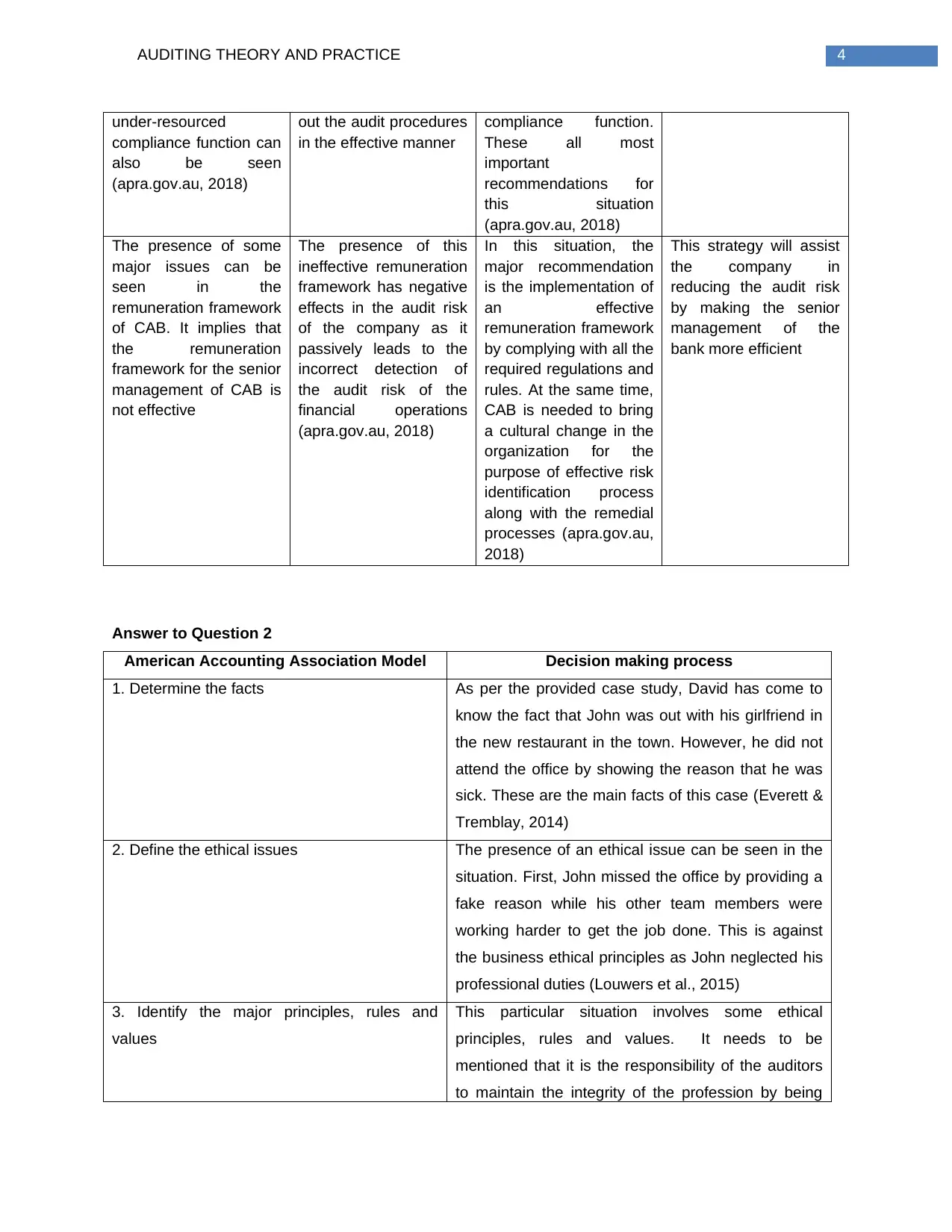
4AUDITING THEORY AND PRACTICE
under-resourced
compliance function can
also be seen
(apra.gov.au, 2018)
out the audit procedures
in the effective manner
compliance function.
These all most
important
recommendations for
this situation
(apra.gov.au, 2018)
The presence of some
major issues can be
seen in the
remuneration framework
of CAB. It implies that
the remuneration
framework for the senior
management of CAB is
not effective
The presence of this
ineffective remuneration
framework has negative
effects in the audit risk
of the company as it
passively leads to the
incorrect detection of
the audit risk of the
financial operations
(apra.gov.au, 2018)
In this situation, the
major recommendation
is the implementation of
an effective
remuneration framework
by complying with all the
required regulations and
rules. At the same time,
CAB is needed to bring
a cultural change in the
organization for the
purpose of effective risk
identification process
along with the remedial
processes (apra.gov.au,
2018)
This strategy will assist
the company in
reducing the audit risk
by making the senior
management of the
bank more efficient
Answer to Question 2
American Accounting Association Model Decision making process
1. Determine the facts As per the provided case study, David has come to
know the fact that John was out with his girlfriend in
the new restaurant in the town. However, he did not
attend the office by showing the reason that he was
sick. These are the main facts of this case (Everett &
Tremblay, 2014)
2. Define the ethical issues The presence of an ethical issue can be seen in the
situation. First, John missed the office by providing a
fake reason while his other team members were
working harder to get the job done. This is against
the business ethical principles as John neglected his
professional duties (Louwers et al., 2015)
3. Identify the major principles, rules and
values
This particular situation involves some ethical
principles, rules and values. It needs to be
mentioned that it is the responsibility of the auditors
to maintain the integrity of the profession by being
under-resourced
compliance function can
also be seen
(apra.gov.au, 2018)
out the audit procedures
in the effective manner
compliance function.
These all most
important
recommendations for
this situation
(apra.gov.au, 2018)
The presence of some
major issues can be
seen in the
remuneration framework
of CAB. It implies that
the remuneration
framework for the senior
management of CAB is
not effective
The presence of this
ineffective remuneration
framework has negative
effects in the audit risk
of the company as it
passively leads to the
incorrect detection of
the audit risk of the
financial operations
(apra.gov.au, 2018)
In this situation, the
major recommendation
is the implementation of
an effective
remuneration framework
by complying with all the
required regulations and
rules. At the same time,
CAB is needed to bring
a cultural change in the
organization for the
purpose of effective risk
identification process
along with the remedial
processes (apra.gov.au,
2018)
This strategy will assist
the company in
reducing the audit risk
by making the senior
management of the
bank more efficient
Answer to Question 2
American Accounting Association Model Decision making process
1. Determine the facts As per the provided case study, David has come to
know the fact that John was out with his girlfriend in
the new restaurant in the town. However, he did not
attend the office by showing the reason that he was
sick. These are the main facts of this case (Everett &
Tremblay, 2014)
2. Define the ethical issues The presence of an ethical issue can be seen in the
situation. First, John missed the office by providing a
fake reason while his other team members were
working harder to get the job done. This is against
the business ethical principles as John neglected his
professional duties (Louwers et al., 2015)
3. Identify the major principles, rules and
values
This particular situation involves some ethical
principles, rules and values. It needs to be
mentioned that it is the responsibility of the auditors
to maintain the integrity of the profession by being
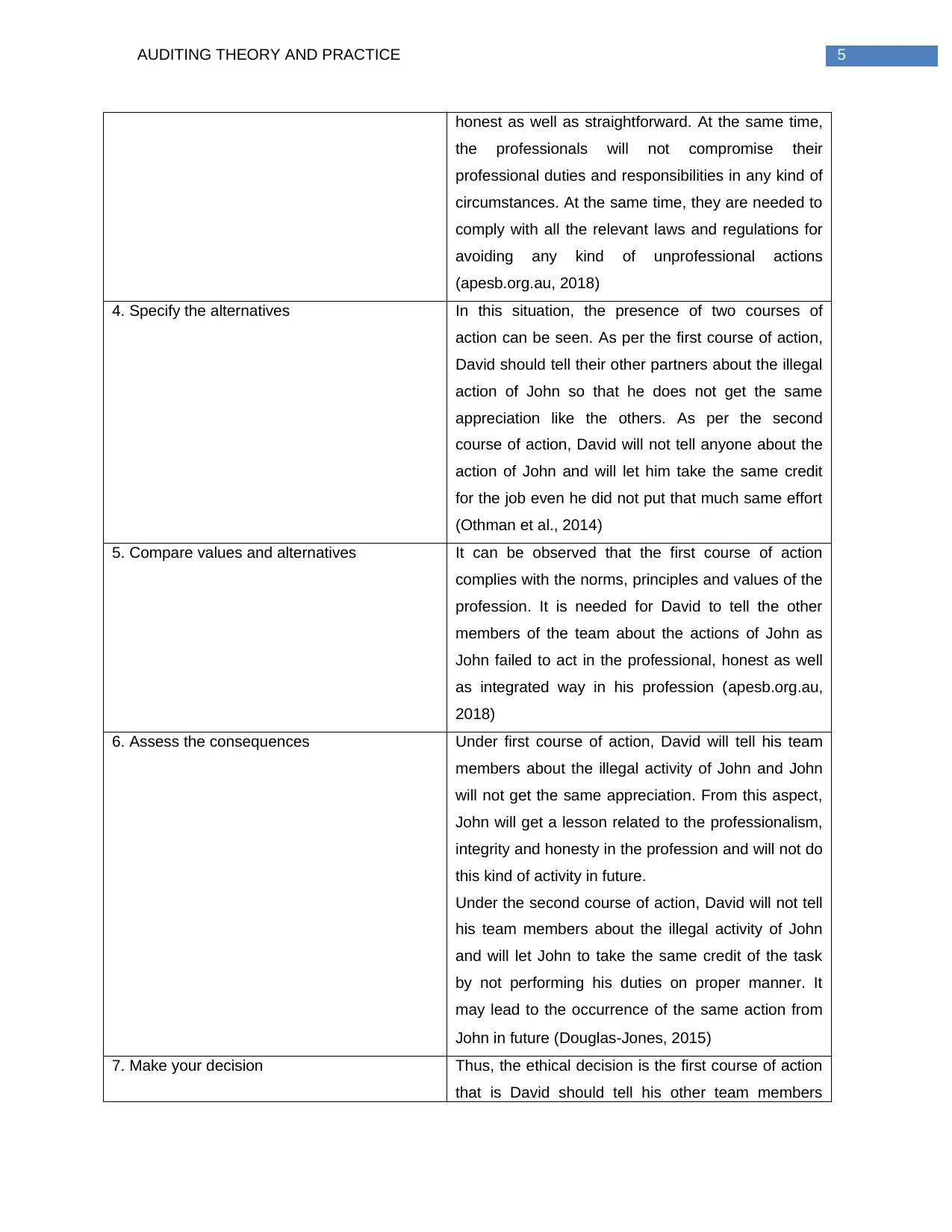
5AUDITING THEORY AND PRACTICE
honest as well as straightforward. At the same time,
the professionals will not compromise their
professional duties and responsibilities in any kind of
circumstances. At the same time, they are needed to
comply with all the relevant laws and regulations for
avoiding any kind of unprofessional actions
(apesb.org.au, 2018)
4. Specify the alternatives In this situation, the presence of two courses of
action can be seen. As per the first course of action,
David should tell their other partners about the illegal
action of John so that he does not get the same
appreciation like the others. As per the second
course of action, David will not tell anyone about the
action of John and will let him take the same credit
for the job even he did not put that much same effort
(Othman et al., 2014)
5. Compare values and alternatives It can be observed that the first course of action
complies with the norms, principles and values of the
profession. It is needed for David to tell the other
members of the team about the actions of John as
John failed to act in the professional, honest as well
as integrated way in his profession (apesb.org.au,
2018)
6. Assess the consequences Under first course of action, David will tell his team
members about the illegal activity of John and John
will not get the same appreciation. From this aspect,
John will get a lesson related to the professionalism,
integrity and honesty in the profession and will not do
this kind of activity in future.
Under the second course of action, David will not tell
his team members about the illegal activity of John
and will let John to take the same credit of the task
by not performing his duties on proper manner. It
may lead to the occurrence of the same action from
John in future (Douglas‐Jones, 2015)
7. Make your decision Thus, the ethical decision is the first course of action
that is David should tell his other team members
honest as well as straightforward. At the same time,
the professionals will not compromise their
professional duties and responsibilities in any kind of
circumstances. At the same time, they are needed to
comply with all the relevant laws and regulations for
avoiding any kind of unprofessional actions
(apesb.org.au, 2018)
4. Specify the alternatives In this situation, the presence of two courses of
action can be seen. As per the first course of action,
David should tell their other partners about the illegal
action of John so that he does not get the same
appreciation like the others. As per the second
course of action, David will not tell anyone about the
action of John and will let him take the same credit
for the job even he did not put that much same effort
(Othman et al., 2014)
5. Compare values and alternatives It can be observed that the first course of action
complies with the norms, principles and values of the
profession. It is needed for David to tell the other
members of the team about the actions of John as
John failed to act in the professional, honest as well
as integrated way in his profession (apesb.org.au,
2018)
6. Assess the consequences Under first course of action, David will tell his team
members about the illegal activity of John and John
will not get the same appreciation. From this aspect,
John will get a lesson related to the professionalism,
integrity and honesty in the profession and will not do
this kind of activity in future.
Under the second course of action, David will not tell
his team members about the illegal activity of John
and will let John to take the same credit of the task
by not performing his duties on proper manner. It
may lead to the occurrence of the same action from
John in future (Douglas‐Jones, 2015)
7. Make your decision Thus, the ethical decision is the first course of action
that is David should tell his other team members
⊘ This is a preview!⊘
Do you want full access?
Subscribe today to unlock all pages.

Trusted by 1+ million students worldwide
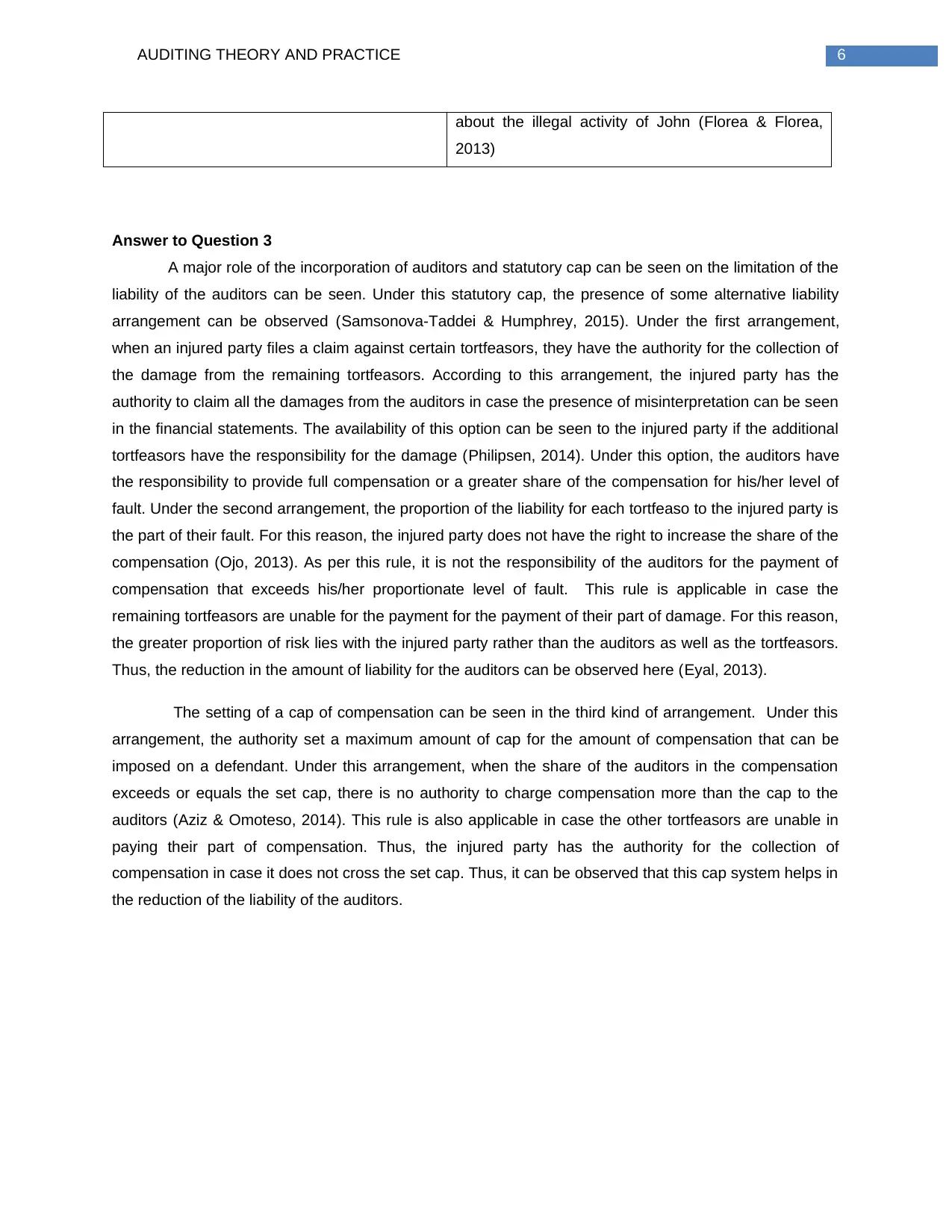
6AUDITING THEORY AND PRACTICE
about the illegal activity of John (Florea & Florea,
2013)
Answer to Question 3
A major role of the incorporation of auditors and statutory cap can be seen on the limitation of the
liability of the auditors can be seen. Under this statutory cap, the presence of some alternative liability
arrangement can be observed (Samsonova-Taddei & Humphrey, 2015). Under the first arrangement,
when an injured party files a claim against certain tortfeasors, they have the authority for the collection of
the damage from the remaining tortfeasors. According to this arrangement, the injured party has the
authority to claim all the damages from the auditors in case the presence of misinterpretation can be seen
in the financial statements. The availability of this option can be seen to the injured party if the additional
tortfeasors have the responsibility for the damage (Philipsen, 2014). Under this option, the auditors have
the responsibility to provide full compensation or a greater share of the compensation for his/her level of
fault. Under the second arrangement, the proportion of the liability for each tortfeaso to the injured party is
the part of their fault. For this reason, the injured party does not have the right to increase the share of the
compensation (Ojo, 2013). As per this rule, it is not the responsibility of the auditors for the payment of
compensation that exceeds his/her proportionate level of fault. This rule is applicable in case the
remaining tortfeasors are unable for the payment for the payment of their part of damage. For this reason,
the greater proportion of risk lies with the injured party rather than the auditors as well as the tortfeasors.
Thus, the reduction in the amount of liability for the auditors can be observed here (Eyal, 2013).
The setting of a cap of compensation can be seen in the third kind of arrangement. Under this
arrangement, the authority set a maximum amount of cap for the amount of compensation that can be
imposed on a defendant. Under this arrangement, when the share of the auditors in the compensation
exceeds or equals the set cap, there is no authority to charge compensation more than the cap to the
auditors (Aziz & Omoteso, 2014). This rule is also applicable in case the other tortfeasors are unable in
paying their part of compensation. Thus, the injured party has the authority for the collection of
compensation in case it does not cross the set cap. Thus, it can be observed that this cap system helps in
the reduction of the liability of the auditors.
about the illegal activity of John (Florea & Florea,
2013)
Answer to Question 3
A major role of the incorporation of auditors and statutory cap can be seen on the limitation of the
liability of the auditors can be seen. Under this statutory cap, the presence of some alternative liability
arrangement can be observed (Samsonova-Taddei & Humphrey, 2015). Under the first arrangement,
when an injured party files a claim against certain tortfeasors, they have the authority for the collection of
the damage from the remaining tortfeasors. According to this arrangement, the injured party has the
authority to claim all the damages from the auditors in case the presence of misinterpretation can be seen
in the financial statements. The availability of this option can be seen to the injured party if the additional
tortfeasors have the responsibility for the damage (Philipsen, 2014). Under this option, the auditors have
the responsibility to provide full compensation or a greater share of the compensation for his/her level of
fault. Under the second arrangement, the proportion of the liability for each tortfeaso to the injured party is
the part of their fault. For this reason, the injured party does not have the right to increase the share of the
compensation (Ojo, 2013). As per this rule, it is not the responsibility of the auditors for the payment of
compensation that exceeds his/her proportionate level of fault. This rule is applicable in case the
remaining tortfeasors are unable for the payment for the payment of their part of damage. For this reason,
the greater proportion of risk lies with the injured party rather than the auditors as well as the tortfeasors.
Thus, the reduction in the amount of liability for the auditors can be observed here (Eyal, 2013).
The setting of a cap of compensation can be seen in the third kind of arrangement. Under this
arrangement, the authority set a maximum amount of cap for the amount of compensation that can be
imposed on a defendant. Under this arrangement, when the share of the auditors in the compensation
exceeds or equals the set cap, there is no authority to charge compensation more than the cap to the
auditors (Aziz & Omoteso, 2014). This rule is also applicable in case the other tortfeasors are unable in
paying their part of compensation. Thus, the injured party has the authority for the collection of
compensation in case it does not cross the set cap. Thus, it can be observed that this cap system helps in
the reduction of the liability of the auditors.
Paraphrase This Document
Need a fresh take? Get an instant paraphrase of this document with our AI Paraphraser
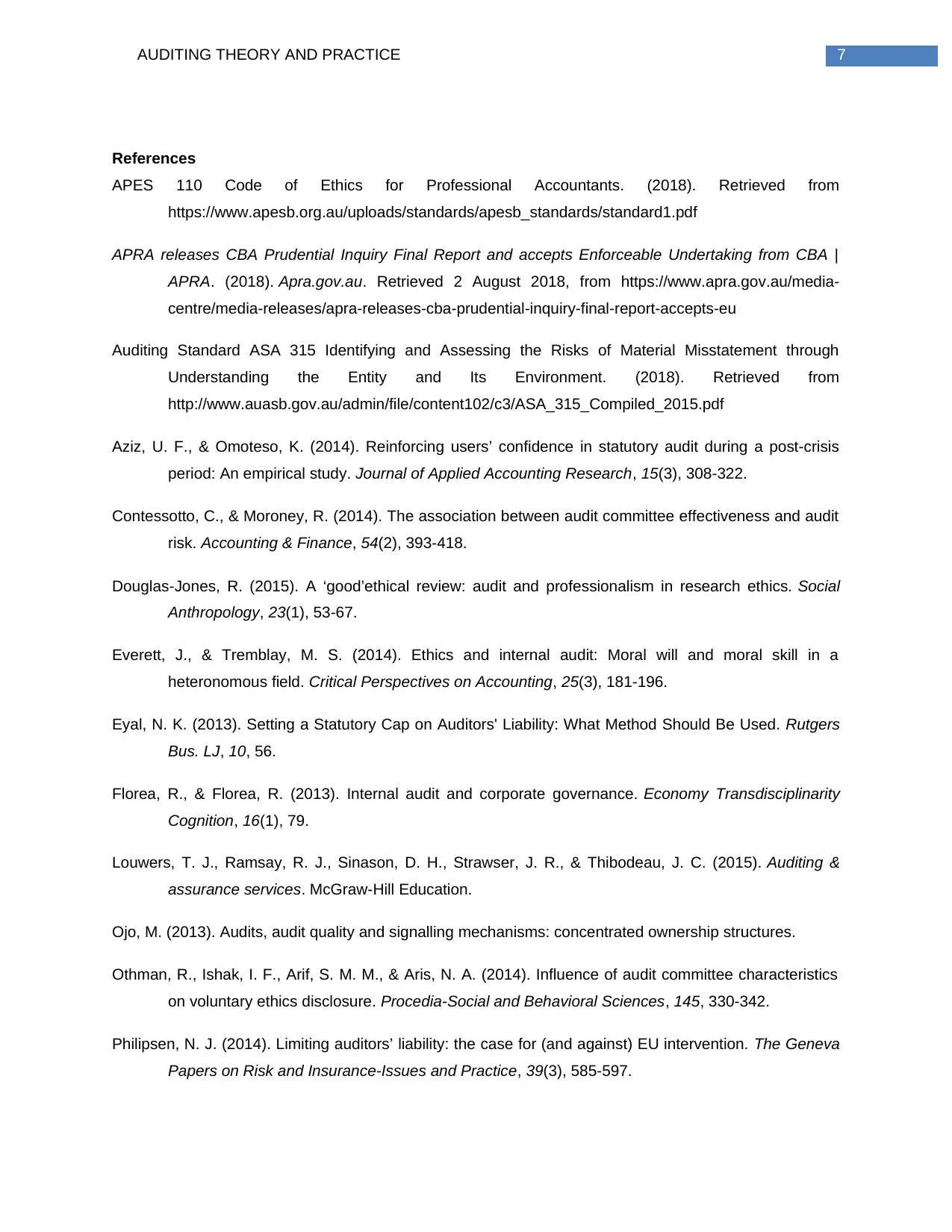
7AUDITING THEORY AND PRACTICE
References
APES 110 Code of Ethics for Professional Accountants. (2018). Retrieved from
https://www.apesb.org.au/uploads/standards/apesb_standards/standard1.pdf
APRA releases CBA Prudential Inquiry Final Report and accepts Enforceable Undertaking from CBA |
APRA. (2018). Apra.gov.au. Retrieved 2 August 2018, from https://www.apra.gov.au/media-
centre/media-releases/apra-releases-cba-prudential-inquiry-final-report-accepts-eu
Auditing Standard ASA 315 Identifying and Assessing the Risks of Material Misstatement through
Understanding the Entity and Its Environment. (2018). Retrieved from
http://www.auasb.gov.au/admin/file/content102/c3/ASA_315_Compiled_2015.pdf
Aziz, U. F., & Omoteso, K. (2014). Reinforcing users’ confidence in statutory audit during a post-crisis
period: An empirical study. Journal of Applied Accounting Research, 15(3), 308-322.
Contessotto, C., & Moroney, R. (2014). The association between audit committee effectiveness and audit
risk. Accounting & Finance, 54(2), 393-418.
Douglas‐Jones, R. (2015). A ‘good’ethical review: audit and professionalism in research ethics. Social
Anthropology, 23(1), 53-67.
Everett, J., & Tremblay, M. S. (2014). Ethics and internal audit: Moral will and moral skill in a
heteronomous field. Critical Perspectives on Accounting, 25(3), 181-196.
Eyal, N. K. (2013). Setting a Statutory Cap on Auditors' Liability: What Method Should Be Used. Rutgers
Bus. LJ, 10, 56.
Florea, R., & Florea, R. (2013). Internal audit and corporate governance. Economy Transdisciplinarity
Cognition, 16(1), 79.
Louwers, T. J., Ramsay, R. J., Sinason, D. H., Strawser, J. R., & Thibodeau, J. C. (2015). Auditing &
assurance services. McGraw-Hill Education.
Ojo, M. (2013). Audits, audit quality and signalling mechanisms: concentrated ownership structures.
Othman, R., Ishak, I. F., Arif, S. M. M., & Aris, N. A. (2014). Influence of audit committee characteristics
on voluntary ethics disclosure. Procedia-Social and Behavioral Sciences, 145, 330-342.
Philipsen, N. J. (2014). Limiting auditors’ liability: the case for (and against) EU intervention. The Geneva
Papers on Risk and Insurance-Issues and Practice, 39(3), 585-597.
References
APES 110 Code of Ethics for Professional Accountants. (2018). Retrieved from
https://www.apesb.org.au/uploads/standards/apesb_standards/standard1.pdf
APRA releases CBA Prudential Inquiry Final Report and accepts Enforceable Undertaking from CBA |
APRA. (2018). Apra.gov.au. Retrieved 2 August 2018, from https://www.apra.gov.au/media-
centre/media-releases/apra-releases-cba-prudential-inquiry-final-report-accepts-eu
Auditing Standard ASA 315 Identifying and Assessing the Risks of Material Misstatement through
Understanding the Entity and Its Environment. (2018). Retrieved from
http://www.auasb.gov.au/admin/file/content102/c3/ASA_315_Compiled_2015.pdf
Aziz, U. F., & Omoteso, K. (2014). Reinforcing users’ confidence in statutory audit during a post-crisis
period: An empirical study. Journal of Applied Accounting Research, 15(3), 308-322.
Contessotto, C., & Moroney, R. (2014). The association between audit committee effectiveness and audit
risk. Accounting & Finance, 54(2), 393-418.
Douglas‐Jones, R. (2015). A ‘good’ethical review: audit and professionalism in research ethics. Social
Anthropology, 23(1), 53-67.
Everett, J., & Tremblay, M. S. (2014). Ethics and internal audit: Moral will and moral skill in a
heteronomous field. Critical Perspectives on Accounting, 25(3), 181-196.
Eyal, N. K. (2013). Setting a Statutory Cap on Auditors' Liability: What Method Should Be Used. Rutgers
Bus. LJ, 10, 56.
Florea, R., & Florea, R. (2013). Internal audit and corporate governance. Economy Transdisciplinarity
Cognition, 16(1), 79.
Louwers, T. J., Ramsay, R. J., Sinason, D. H., Strawser, J. R., & Thibodeau, J. C. (2015). Auditing &
assurance services. McGraw-Hill Education.
Ojo, M. (2013). Audits, audit quality and signalling mechanisms: concentrated ownership structures.
Othman, R., Ishak, I. F., Arif, S. M. M., & Aris, N. A. (2014). Influence of audit committee characteristics
on voluntary ethics disclosure. Procedia-Social and Behavioral Sciences, 145, 330-342.
Philipsen, N. J. (2014). Limiting auditors’ liability: the case for (and against) EU intervention. The Geneva
Papers on Risk and Insurance-Issues and Practice, 39(3), 585-597.
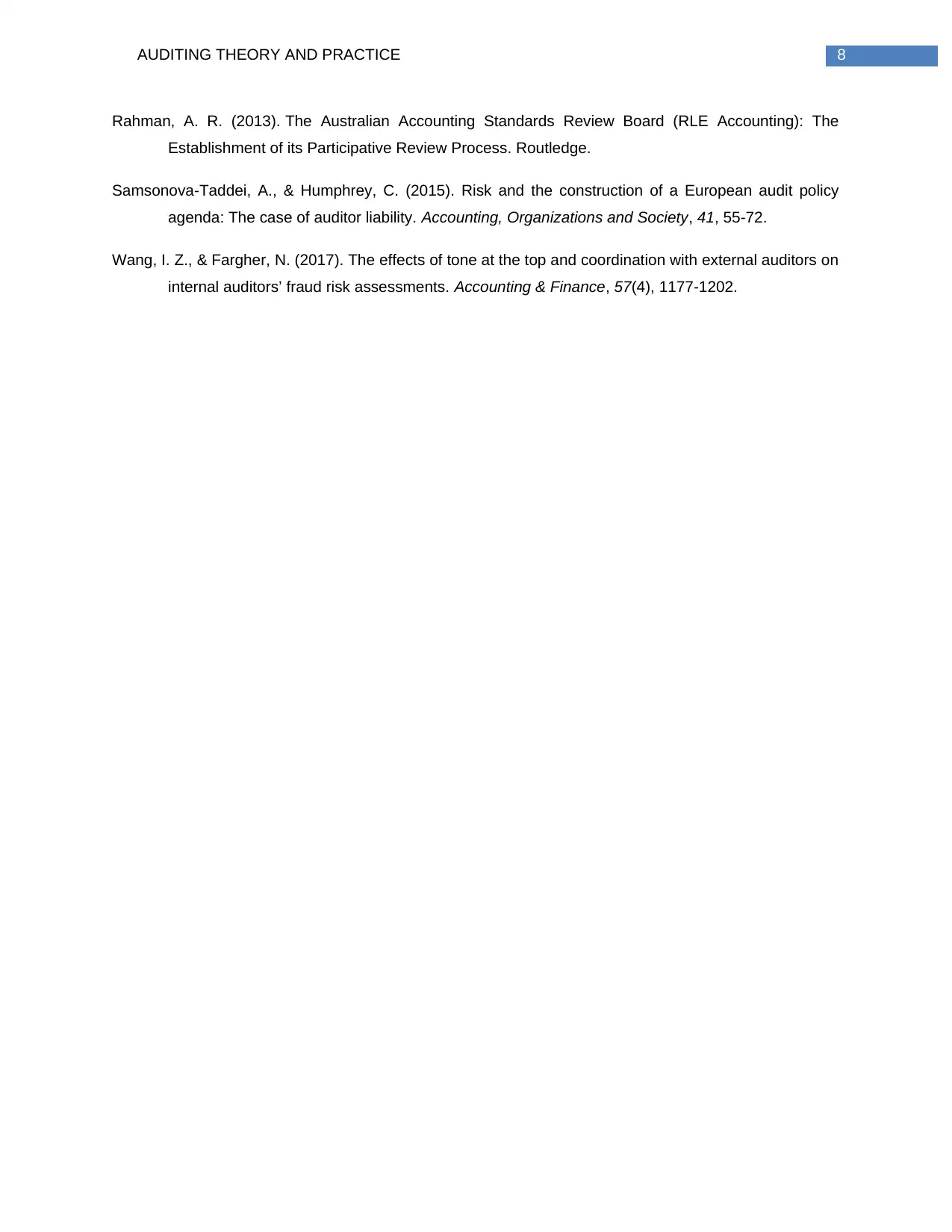
8AUDITING THEORY AND PRACTICE
Rahman, A. R. (2013). The Australian Accounting Standards Review Board (RLE Accounting): The
Establishment of its Participative Review Process. Routledge.
Samsonova-Taddei, A., & Humphrey, C. (2015). Risk and the construction of a European audit policy
agenda: The case of auditor liability. Accounting, Organizations and Society, 41, 55-72.
Wang, I. Z., & Fargher, N. (2017). The effects of tone at the top and coordination with external auditors on
internal auditors’ fraud risk assessments. Accounting & Finance, 57(4), 1177-1202.
Rahman, A. R. (2013). The Australian Accounting Standards Review Board (RLE Accounting): The
Establishment of its Participative Review Process. Routledge.
Samsonova-Taddei, A., & Humphrey, C. (2015). Risk and the construction of a European audit policy
agenda: The case of auditor liability. Accounting, Organizations and Society, 41, 55-72.
Wang, I. Z., & Fargher, N. (2017). The effects of tone at the top and coordination with external auditors on
internal auditors’ fraud risk assessments. Accounting & Finance, 57(4), 1177-1202.
⊘ This is a preview!⊘
Do you want full access?
Subscribe today to unlock all pages.

Trusted by 1+ million students worldwide
1 out of 9
Related Documents
Your All-in-One AI-Powered Toolkit for Academic Success.
+13062052269
info@desklib.com
Available 24*7 on WhatsApp / Email
![[object Object]](/_next/static/media/star-bottom.7253800d.svg)
Unlock your academic potential
Copyright © 2020–2025 A2Z Services. All Rights Reserved. Developed and managed by ZUCOL.



